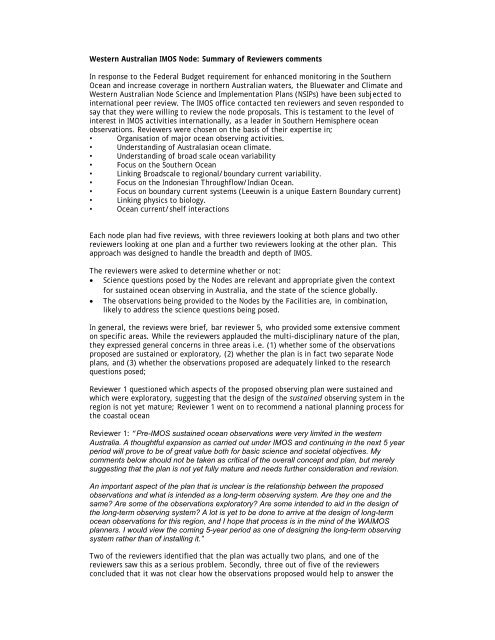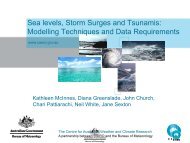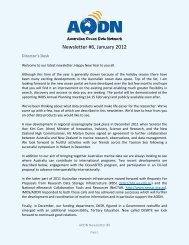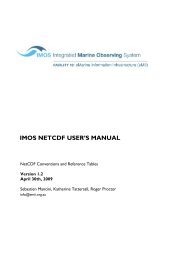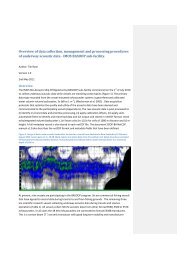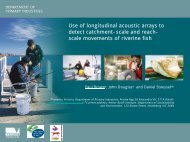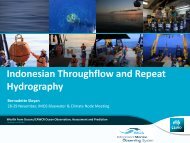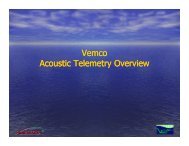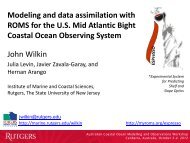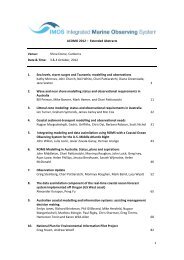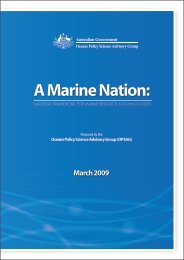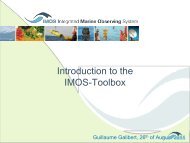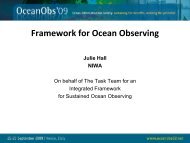WAIMOS Review comments
WAIMOS Review comments
WAIMOS Review comments
You also want an ePaper? Increase the reach of your titles
YUMPU automatically turns print PDFs into web optimized ePapers that Google loves.
Western Australian IMOS Node: Summary of <strong>Review</strong>ers <strong>comments</strong>In response to the Federal Budget requirement for enhanced monitoring in the SouthernOcean and increase coverage in northern Australian waters, the Bluewater and Climate andWestern Australian Node Science and Implementation Plans (NSIPs) have been subjected tointernational peer review. The IMOS office contacted ten reviewers and seven responded tosay that they were willing to review the node proposals. This is testament to the level ofinterest in IMOS activities internationally, as a leader in Southern Hemisphere oceanobservations. <strong>Review</strong>ers were chosen on the basis of their expertise in;• Organisation of major ocean observing activities.• Understanding of Australasian ocean climate.• Understanding of broad scale ocean variability• Focus on the Southern Ocean• Linking Broadscale to regional/boundary current variability.• Focus on the Indonesian Throughflow/Indian Ocean.• Focus on boundary current systems (Leeuwin is a unique Eastern Boundary current)• Linking physics to biology.• Ocean current/shelf interactionsEach node plan had five reviews, with three reviewers looking at both plans and two otherreviewers looking at one plan and a further two reviewers looking at the other plan. Thisapproach was designed to handle the breadth and depth of IMOS.The reviewers were asked to determine whether or not:• Science questions posed by the Nodes are relevant and appropriate given the contextfor sustained ocean observing in Australia, and the state of the science globally.• The observations being provided to the Nodes by the Facilities are, in combination,likely to address the science questions being posed.In general, the reviews were brief, bar reviewer 5, who provided some extensive commenton specific areas. While the reviewers applauded the multi-disciplinary nature of the plan,they expressed general concerns in three areas i.e. (1) whether some of the observationsproposed are sustained or exploratory, (2) whether the plan is in fact two separate Nodeplans, and (3) whether the observations proposed are adequately linked to the researchquestions posed;<strong>Review</strong>er 1 questioned which aspects of the proposed observing plan were sustained andwhich were exploratory, suggesting that the design of the sustained observing system in theregion is not yet mature; <strong>Review</strong>er 1 went on to recommend a national planning process forthe coastal ocean<strong>Review</strong>er 1: “Pre-IMOS sustained ocean observations were very limited in the westernAustralia. A thoughtful expansion as carried out under IMOS and continuing in the next 5 yearperiod will prove to be of great value both for basic science and societal objectives. My<strong>comments</strong> below should not be taken as critical of the overall concept and plan, but merelysuggesting that the plan is not yet fully mature and needs further consideration and revision.An important aspect of the plan that is unclear is the relationship between the proposedobservations and what is intended as a long-term observing system. Are they one and thesame? Are some of the observations exploratory? Are some intended to aid in the design ofthe long-term observing system? A lot is yet to be done to arrive at the design of long-termocean observations for this region, and I hope that process is in the mind of the <strong>WAIMOS</strong>planners. I would view the coming 5-year period as one of designing the long-term observingsystem rather than of installing it.”Two of the reviewers identified that the plan was actually two plans, and one of thereviewers saw this as a serious problem. Secondly, three out of five of the reviewersconcluded that it was not clear how the observations proposed would help to answer the
science questions posed. This makes it extremely difficult to prioritise the observationsrequested.<strong>Review</strong>er 2 went on to suggest that no enhancements to the regional observations areapproved without a significant re-write, and reviewer 5 also recommended significantrevisions:<strong>Review</strong>er 2: “The proposal is a long document outlining the node science andimplementation plans. I was surprised to find more or less two separate discussions andproposals under one common NODE, the north-west Australian Waters and the south-westAustralian Waters. This made it more difficult to read and evaluate the proposal, and eventhe structure under the four given headings was chosen differently between the twosubregions. I would like to flag this right upfront as a serious concern that needsaddressing. Either IMOS decides to break the node in to two, or it ensures properintegration. But the current proposal is an unacceptable compromise…..… On the basis of what is written here I would strongly urge the funders to supportongoing activities, but at the same time demand for a much more convincing andintegrated observing strategy. I find it unacceptable that I have to read two plans in one.”<strong>Review</strong>er 5: “Proposal format is apparently defined by a template that <strong>WAIMOS</strong> wasinstructed to follow. I did not care for the structure, mainly because there was nopresentation of the actual observing system to be deployed until page 60 or so. I wish theauthors had chosen to use the introduction to provide a more detailed summary, it wouldhave made it much easier to follow the rationale of the rest of the proposal. Theproposal itself is rather sloppy, there are a lot of grammar and syntax errors throughout,the description of the physical regimes are not entirely consistent, figure references arewrong in a number of places, many place names are not shown in the graphics and thesubsections are mis-numbered in places. The presentation is therefore less clear than itcould be, and if the document is to be shared publicly the authors should be asked tocarefully revise it beforehand.…… Overall I’d rate the proposal a good – there is ample solid material included, thequestions posed are fundamental and worthy of significant investment, and the observingsystem proposed is a prudent balance between what is desired and what is possible givenbudgetary and logistical constraints. It does not convey a sense of the build out plan thatwill be necessary to tackle many of the research topics, or how this initial effort factorsinto a grander scheme.”Regarding the specific responses to the questions set;1) Whether the Science questions posed by the Nodes are relevant and appropriategiven the context for sustained ocean observing in Australia, and the state of thescience globally.In general, reviewers approved of the balance of the science questions posed, andapplauded the multi-disciplinary nature, and socio-economic context. It was noted that thequestioning in some areas were more developed than others.<strong>Review</strong>er 2: “The scientific background begins with a good description of the large scalecontext for the Northern Section. BUT are there no common issues for both regions thatwould have warranted a joint discussion? However, I was surprised that issues like increasein CO2 uptake and ocean acidification were not prominently mentioned, also I would haveexpected some mention of sea level rise (maybe not relevant) or changes in the terrestrialinput (nitrification, loss of oxygen, maybe both not relevant?).”<strong>Review</strong>er 3: “As a summary, this is an impressive effort to develop a comprehensiveregional observing system. The science questions posed are fully relevant and
appropriate. Socio economics context is a strong driver…. The research questioning issomehow less developed for the SW Australian part; I believe this was already done in thefirst <strong>WAIMOS</strong> document. I did not find materials to estimate if <strong>WAIMOS</strong> fulfilled theproposed objectives (i.e. p. 52), but maybe this was done in earlier reviews.”<strong>Review</strong>er 4: “I found the proposal well-written with a clear presentation of thebackground knowledge, research questions and outreach of the proposed measurements.Those are relevant to broad scale climate and variability, continental slope, shelf andcoastal processes.”<strong>Review</strong>er 5: “Overall, the general themes (forecasting, biodiversity and productivity andmanaging and planning for human use) were appropriate to the regional program and tothe present state of the observing system. The specific research topics were bestdeveloped for the forecasting theme, less so for the biodiversity and productivity, andmixed for human use.….. To be more positive, the proposal is delightfully multidisciplinaryand the authors are to be commended for the breadth of information theyhave assembled and condensed. I’m impressed that the basic themes include a strongbiological component and applaud the use of passive acoustics and tagging for monitoring.Some more specific concerns I would voice are the lack of discussion about the setting andobserving along the southern shore of Australia; about the connection to the bluewater,climate and other regional nodes;”2) The extent to which the observations being proposed will, in combination addressthe science questions being posed.As mentioned above, the general concern here is that while a comprehensive list of sciencequestions, it is not clear how the observing system proposed relates to these questions. 3out of 4 of the reviewers agreed on this point.<strong>Review</strong>er 2: “I think from my point of view the plan is very weak in this aspect. While atthe high level end of the plan the overarching issue are spelled out and from myperspective seem very convincing, the issue of how those translate to a sustainedobserving system has not been addressed in a systematic way. This is very hard to do and Iwould not expect a full and ‘correct’ answer. But at the minimum a framework for thatprocess should be established and described. As it stands one could say this is a collectionof nice ideas for a specific task, but their joint resolving and describing power has notbeen assessed or presented.”<strong>Review</strong>er 3: “The proposed plan makes sense. It is not clear, however, how the differentdata sets will be integrated together and will answer science and societal questions. Anintegrating framework through physical, biogeochemical and ecosystem coastal modelingseems to be lacking (or is not described).”<strong>Review</strong>er 4: “The observations will provide essential measurements to better understandthe natural variability, long term changes, and improved physical, biogeochemical andecological modeling.”<strong>Review</strong>er 5: “A general concern is that the connection between the scientific/societalneeds (as stated in the research themes and subthemes) and the observing system was notterribly well spelled out. I find the motivation (in terms of scientific themes) to beexpressed as long-term views, with little accounting for the necessary build-up ofcapabilities that this 5-year development and implementation plan addresses. The resultis a disconnection between the perceived goal and the requirements to meet the goal andwhat is possible/feasible in the near-term to move towards satisfying that goal…..… [Some specific concerns are] about some of the observing efforts (CO2, sediment traps)that appear in the observing system description but are never mentioned (and thusjustified) earlier.”
<strong>Review</strong>er 1 went on to question the human resources required for the proposed observingsystem, the demands of overseeing and running such a system and the demands on the timeof the Node Leader:<strong>Review</strong>er 1: “ Human resources. It appears questionable whether there is or will be in thenext few years enough technical expertise to initiate and(possibly) sustain all of theproposed observations. Although the proposal does not address this issue directly, it givessome reason for concern, e.g. final sentence on p 56. The hiring of new technical staff is anecessary but not a sufficient step; the training and supervision of such staff is a majorand important function in the observing system. Who are the observational/instrumentation experts among the <strong>WAIMOS</strong> team who will carry this responsibility?University partnerships. This reviewer is a university professor and accepts that universitybasedscientists play a strong role in sustained ocean observations. Nevertheless, oceanobservations and especially sustained ocean observations go against the grain of universityevaluation and rewards systems. Is this an issue for <strong>WAIMOS</strong>? For a national program onemight expect to see CMAR playing a stronger integrative role in developing the observingsystem.”1. Introduction<strong>Review</strong>er 5: “OK, though the field plan associated with Figure 1 could be more clear.What is new, what is not? Presumably red exists, white does not, but it is never stated.Nor is the red dot at NW Cape mentioned. How will new lines be instrumented? TheArafura line is said to be moorings – the same is true of others? Good rationale, thoughterse.”2. Socio-economic context<strong>Review</strong>er 2: “I found it difficult to digest section 2 on the socioeconomic context, becauseit read to me like a collection of stakeholder statements and not a well synthesized andstructured high level discussion on relevance. For example I support the five categories onpage 7, but then they are not filled with more meat in the context of the WAMOSdiscussion. It is maybe not an essential part of the proposal, but one that might needattention for the next round.Section 2.2.1 read in many places more like a research agenda, than something in supportof the socioeconomic context.Section 2.2.2 has excellent element and maybe could be seen as the intro to section 3.While section 2.2.3 for the South-West regions does address more the socio economiccontext.”<strong>Review</strong>er 3: “The socio-economics aspects (characterization of biodiversity, regionalmanagement, ecosystem based management, design criteria for offshore structures) arewell covered and the critical importance of observations is emphasized.”<strong>Review</strong>er 5: “Socio-economic context – not sure why a bullet is used in the first section,odd to just have one. I realize the point here is that there are restrictions on the use ofthe funds. But should be presented another way.”Section 2.1: seems rather standard; don’t’ see a clear connection between theobservations to be collected and the opportunities and challenges identified. A clearerconnection would help justify the existence and continued funding of IMOS.It needn’t be exhaustive but some description of the observations that will improvenational security, conserve biodiversity, etc would be helpful. The list of quotesemphasizes the issues the region is facing but again fails to relate specific observingneeded to address these issues.Section 2.2.1 – just what I was looking for. The ATS section is good though a bit scatteredin the 2nd to last paragraph. Lots of justification for observing, not so much on what
observing is needed. Ocean Research Priorities section – lapsing into acronyms that arenot spelled out (MODIS, NMR, CARS-type, etc). Understanding of Arafura Sea section –bluelink needs to be defined. Some issues with grammar. Need Torres Strait on a mapsomewhere. End of the section: good summary of socio-economic topics to be addressed,but would be best if these came earlier, then provide the details.Section 2.2.2 - subsection A is good, specific, to the point; subsection B is less so (crossshelfwater flow? effects of tidal dynamics on marine habitats?), and could be morespecific. The two topics I’ve picked on are quite complex and obviously <strong>WAIMOS</strong> isn’tgoing to address all aspects, be more specific about what can be achieved in these broadareas; subsection C – could point out economic advantage of re-using the informationcollected to support A and B in C; the tide-induced bottom-stress seems not to fit – isn’t itlikely to be highly variable in space and time and beyond the resolution of the <strong>WAIMOS</strong>infrastructure?Section 2.2.3 – brief, and assumes familiarity with existing programs. Does not parallelthe other sections very well. Of limited help in placing the existing system in the samecontext.”3. Scientific Background:<strong>Review</strong>er 2: “In general I thought the structure of discussion for each issue was helpful,although no indication of readiness and or costs (cost effectiveness) to tackle the issue wasgiven.Section 3.2 for the South Western Water was structured quite differently with a good andsomewhat detailed description of the science issues. I was surprised to find thatbiogeochemistry was only discussed in the context of nutrients and Chla. Are there nohigher trophic level issues of interest?Section 3.2.7 (labeled wrongly as 3.2.3) addresses the science questions. Interesting thatENSO was mentioned as the first point including its impact on the north-western region,but was not directly picked up from the previous section (indirectly yes, because the link isin some parts through the ITF but not only). I liked the response to the mid term review(section 3.2.8).”<strong>Review</strong>er 3: “There is a good review of the scientific background that covers a wide rangeof topics. For the northern region, twelve science challenges are identified for threedifferent (interlinked) themes (ocean and atmospheric weather forecasting, biodiversityconservation and ocean productivity, managing and planning for human use). For eachscientific challenge, research objectives, activities and outputs and key research personnelare identified. For the southwest region where research programs are considered muchmore mature, the research questions are quite specific for the two themes (ocean andclimate forecasting, including continental shelf processes, biodiversity conservation andocean productivity).”<strong>Review</strong>er 5: “Overall, the general themes (forecasting, biodiversity and productivity andmanaging and planning for human use) were appropriate to the regional program and tothe present state of the observing system. The specific research topics were bestdeveloped for the forecasting theme, less so for the biodiversity and productivity, andmixed for human use…..For some of the themes the topic was too broad (e.g. B-3, cross-shelf water flows) andothers were too specific (e.g. C-3, bottom stress) relative to what can reasonably beaccomplished with the observing assets discussed. Obviously with only a few transectsspaced 100s of kms apart only certain cross-shelf exchange processes can be investigated.And with regard to bottom stress, only barotropic dynamics are to be considered, soquantifying the barotropic tidal dynamics would be a better statement of the researchquestion. But the general attention to characterizing the long-shore flow environment, itsvariability and the biological consequences came through clearly and is an appropriatetarget for an initial deployment effort. I strongly suggest that Section 8 be copied in the
front sections of the proposal It is the clearest statement of science to be accomplished inthe 5-year period.”Specific <strong>comments</strong> are:“Leeuwin Current section: the presentation about the LC is confusing, mainly because theintroductory material (section 1) portrays it as extending from at least the east Timor Sea,whereas Figure 2 and the text discuss its origins as being in the western Timor Sea. Figure2 also contains much more detail than is presented in the text, and is not terriblyconsistent with the verbal description (e.g. eastern flow at 15S turning southward to formthe LC). Third sentence should be revised to say the LC is the only poleward flowing EBCIN SUBTROPIC LATITUDES – a big point. Plenty exist in the northern hemisphere but athigher latitudes. The text is a bit sloppy in places (e.g. should be recruitment in manyfisheries, not many of the fisheries recruitments; and the last sentence in each of the last2 paragraphs are nearly identical).Holloway Current section: should be some mention of its connection to/role in the originsof the LC. Have very different depictions of the current structure in Figs 1 and 2. Doesthe LC exist offshore of the HC? Or is the HC the origins of the LC?Ocean drivers section: OK. Good to identify connections to Indian Ocean programs.3.1.2 – region context –tide regime, 2 nd paragraph: poor grammar, makes it hard to read (about tidal fronts).Figure 5b – presume these are the depth-averaged tidal current ellipses?Internal tides – impressive figures and important to note, but will they be observed?Wind driven circulation – little context for what is said here. Reference to Fig 6 is made,yet the figure caption points out tidal fronts, not wind-driven upwelling.Biological environment: lots of information here, and demonstrates the diversity of lifeand the scarcity of information known about its variability and controls on its abundance.Grammar is poor at times in this section, and in places there may be missing text (e.g.coral reef paragraph on p27 that suddenly turns into a discussion of sea grasses).Section 3.1.3 – this format of presentation is not very helpful, many of the lists requirespecialized knowledge (e.g. government policies and programs) or are of limited value aspresented (e.g. IMOS data streams and infrastructure). In Challenge A-1 suggest replacingtidal elevation and sea level elevation – the long-term pressure gradients are of as much ormore interest than the tidal elevation changes.Note that the A challenges listed are not the same as those listed in section 2.2.2, andthroughout the verbal description that goes with a given sub-challenge is not consistent.B-1: goes from water quality initially to water temperature under research objectives.Which is it?B-2: despite the title of the section being larval and genetic exchange there does notappear to be any observing element to measure larvae or determine their genetics. Thetitle needs to reflect that <strong>WAIMOS</strong> is CONTRIBUTING to the challenge by providingcirculation information, not measuring the biology directly. Subtle but importantdistinction.B-3: some recognition of how these depth-dependent processes (at least in some cases) willbe observed would be helpful.
B-4: after listing a number of internal processes (front, internal tides, boundary layerdynamics) the research objective is listed as barotropic modeling, which has limited abilityto address the stated challenges. Need to be consistent.B-5: ambitious but sounds good. B-6 seems very similar - could these two be combined?C-2: so is this nested modeling within Bluelink? Any coupling? Sustained and operational?Chance to discuss connection to bluewater/climate but not here at present.Table 2: shouldn’t box priority 1/C-2 be checked? And priority 5/B-6?3.2.4 – nice, informed discussion of nutrient dynamics.3.2.5, 3.2.6 – nice overview of understanding of more local phenomena and their role instructure the physical and biological environments.It would be nice to see the questions posed for the SW Australian part of <strong>WAIMOS</strong> to be setup better by structured discussion in the preceding section. Could even envision ending abackground section with ‘outstanding issues’ that need to be addressed. As now presentedthe connection is weak and these challenges appear a bit out of thin air.End of section 3: I still don’t have a clear understanding of what is being proposed.Obviously some locations will be instrumented but with what and how has not been stated.Given I’m 55 pages into the proposal that isn’t helpful. Desperately needs a summary ofsome sort up front to give it away.No significant discussion of oceanographic conditions east of Cape Leeuwin.”5. What observations does the Node require during 2009-2013, and how will theyaddress the research questions?<strong>Review</strong>er 1: “Long time-series. All of the proposed long time-series likely have value, butnot equal value or equal cost-effectiveness. And, not all valuable oceanographicobservations should be made into long time-series. Some elements of the plan appear tobe relatively costly in relation to their information content, and unlikely to be sustained,including the many AUV transects and the use of ADCP on NRS moorings. The initiation oflong time-series carries responsibility and obligation that should not be taken on lightly.Analogous to point 1 above, it's critical to avoid having the sustained observing system bethe sum of all time-series observations carried out or envisioned by the participants.”<strong>Review</strong>er 2: “Table 4 gives a helpful overview. In general this is more of a work in progresswhere excellent parts of a complete observing system exists that should be maintained andseen in a larger scale and more integrated context. And the structure of the documentmakes it somewhat difficult to assess the prospect of success. But in some parts there isevidence for a more system based thinking while in others is sounds more like a collectionof efforts justified by local challenges with a somewhat diffuse strategy of how they willmake a difference for the larger scale issue…”<strong>Review</strong>er 3: “Observations required by the northern and north west Australian water Nodeare then analyzed for the different science challenges (a given observation systemaddresses, however, many scientific challenges as the objective should be to design a“core” system that serves several scientific objectives)….…………The proposed observations make sense but it is difficult to figure out how prioritieswere defined. There is also no discussion on the specific requirements of physical andbiogeochemical coastal models and how the IMOS data sets will be used in conjunctionwith modeling and data assimilation systems. Coastal stations and inputs from rivers donot seem to be well covered in the proposal……………It is also difficult to figure out how the
new observing systems will be set up. Will there be enough qualified personnel to makesure that good data are delivered in a timely fashion?”<strong>Review</strong>er 4: “The proposed observations are ambitious and multi-disciplinary and relevantto society needs.. The research questioning is somehow less developed for the SWAustralian part; I believe this was already done in the first <strong>WAIMOS</strong> document. I did notfind materials to estimate if <strong>WAIMOS</strong> fulfilled the proposed objectives (i.e. p. 52), butmaybe this was done in earlier reviews.”<strong>Review</strong>er 5: “The proposed observing system enhancements were reasonably clear but asstated about the linkage between research topic and infrastructure could be improved. -……………..That said, deployment of ADCPs, vertical arrays to measure scalars(temperature, salinity, fluorescence, etc), gliders, and passive acoustics is consistent withpractices in other parts of the globe and should provide a valuable starting point for theobserving system. The deployments will also provide a valuable lesson in how difficultmaintenance will really be for the more remote locations.Specifics include:Page 67: CO2 measurements – first mention of this, should have been called for earlier.Same with sediment traps. Need to be specific that AUV surveys are to map benthicpopulations.Long-term monitoring of E. Radiata – seems like an almost verbatim repeat of lastparagraph in last section.”Comments on specific elements:HF Radar<strong>Review</strong>er 2: “it is not clear to me what will be gained from the HF radar system. I am surethey are very helpful for port and ship operations, and they might be able to detect somelocal changes in the flow. But should I interpret this activity as a template for manyregions? Or is this a shared resource between the port operators and environmentalobserving system?”<strong>Review</strong>er 3: “Is there also a specific reason why HF radars are not considered for theNorthern region?”Gliders<strong>Review</strong>er 2: “One could also ask questions about the glider work. I was impressed by theresults from the SLOCUM deployment, but my immediate reaction was that there is littlecorrelation between surveys, i.e. one wants more. But then the plan proposed to useSeagliders on a zig-zag along the coast, where no single section would be repeated. Howwill these data make a difference to the science issue?”<strong>Review</strong>er 1: “As one example, consider the proposed Seaglider surveys of Fig 25. The planis spatially extensive, but with 3-monthly repetition would be temporally aliased. I'dsupport this as an exploratory effort but probably not as a plan for the next 20 years.Long-term observations would need to focus on key locations (unless the glider program isgreatly increased) and higher frequency sampling. Moreover, glider technology, while nownearly mature, requires a very high level of technical support, and the Seaglider is themost technically sophisticated of the designs. I would hope that deepwater gliders can bemaintained in Australia, and that may not prove feasible with the Seaglider. So in otherwords there are substantial remaining issues to be worked out with both the science andthe technology. Nevertheless, gliders promise to be an exceptionally valuable tool incoastal and coastal-to-blue water environments, and investment in solving the remainingissues is highly justified.”AUV
<strong>Review</strong>er 4: “Coral Reefs, and more generally the benthic community are under highthreat by acidification, global warming and local anthropogenic pressures. They are notaddressed here, but it is proposed to follow marine animals. The proposed observation ofthe physical parameters and CO2 will help documenting this. However, I would highlyrecommend an associated program (which may already exist) dealing with at least theCoral Reefs health, if not the whole benthic ecosystem.”6. Implementation Plan – July 2009 to June 2013<strong>Review</strong>er 5: “ Section 6.1 – Why PIES on the ITF line? By whom? Why on the shelf? Looksshallow enough for ADCPs. Presume again this is a connection to bluewater/climate butfailed to be stated7. Describe how data provided by IMOS will be taken up and used by the Node<strong>Review</strong>er 3: “There is a long list of research organizations and universities that is given insection 7 but it is not clear to me how they will be involved in the scientific analysis ofdata from this node.”<strong>Review</strong>er 5: “It was clear that circulation modeling will be an integral part of theobserving effort in NWA but exactly what will be done wasn’t clearly spelled out. Thisomission may be due to funding constraints (can the funds only go toward infrastructure,and modeling is not considered infrastructure?) but a simple list of modeling componentsto be utilized would be helpful.”8. Describe what impact the IMOS observations will have regionally, nationally andglobally:Section 8 – should appear a LOT earlier


